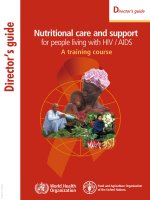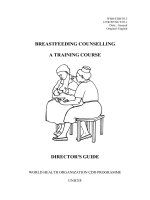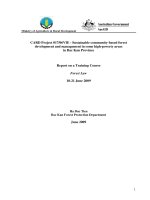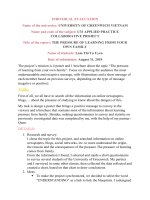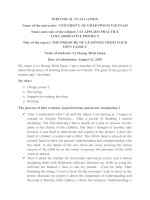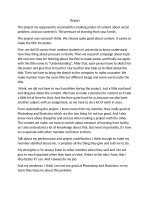Professional practice INDIVIDUAL REPORT planning a training event unit 3 professional practice
Bạn đang xem bản rút gọn của tài liệu. Xem và tải ngay bản đầy đủ của tài liệu tại đây (1.81 MB, 29 trang )
Professional Practice
INDIVIDUAL REPORT
Planning a training Event
Teacher: Ngo Ngoc Tri
Student Name: Tran Quang Huy
Class: GCD0825
ASSIGNMENT 1 FRONT SHEET
Qualification
BTEC Level 5 HND Diploma in Computing
Unit number and title
Unit 3: Professional Practice
Submission date
Date Received 1st submission
Re-submission Date
Date Received 2nd submission
Student Name
TRAN QUANG HUY
Student ID
GCD18457
Class
GCD0825
Assessor name
NGO NGOC TRI
Student declaration
I certify that the assignment submission is entirely my own work and I fully understand the consequences of plagiarism. I
understand that making a false declaration is a form of malpractice.
HUY
Student’s signature
Grading grid
P1
P2
P3
P4
P5
P6
M1
M2
M3
M4
D1
D2
D3
Summative Feedback:
Grade:
Resubmission Feedback:
Assessor Signature:
Internal Verifier’s Comments:
Signature & Date:
Date:
Contents
INTRODUCTION ....................................................................................................................................... 1
CHAPTER 1: DEMONSTRATE A RANGE OF INTERPERSONAL AND TRANSFERABLE
COMMUNICATION SKILLS TO A TARGET AUDIENCE .........................................................................2
1. Demonstrate, using different communication styles and formats, that you can effectively
design and deliver a training event for a given target audience. .....................................................2
2.
1.1.
Banners ................................................................................................................................... 2
1.2.
Meeting minutes ......................................................................................................................3
1.3.
Social Network ......................................................................................................................... 4
1.3.1.
Facebook .............................................................................................................................4
1.3.2.
Gmail ...................................................................................................................................4
Demonstrate that you have used effective time management skills in planning an event......5
2.1.
Team Gannt.............................................................................................................................6
2.2.
Trello .......................................................................................................................................6
3. Design a professional schedule to support the planning of an event, to include
contingencies and justifications of time allocated. ...........................................................................7
4. Evaluate the effectiveness and application of interpersonal skills during the design and
delivery of a training event..................................................................................................................8
CHAPTER 2: APPLY CRITICAL REASONING AND THINKING TO A RANGE OF PROBLEMSOLVING SCENARIOS ............................................................................................................................ 9
1. Demonstrate the use of different problem-solving techniques in the design and delivery of
an event. ............................................................................................................................................... 9
2.
1.1.
List the risks.............................................................................................................................9
1.2.
Risk assessment.................................................................................................................... 11
Demonstrate that critical reasoning has been applied to a given solution. ...........................13
3. Research the use of different problem-solving techniques used in the design and delivery
of an event.......................................................................................................................................... 14
4.
5.
Justify the use and application of a range of solution methodologies. .................................. 15
4.1.
Reduce risk............................................................................................................................ 15
4.2.
Communication......................................................................................................................15
4.3.
Checklist ................................................................................................................................15
Critique the process of applying critical reasoning to a given task/activity or event. ...........16
CHAPTER 3: DISCUSS THE IMPORTANCE AND DYNAMICS OF WORKING WITHIN A TEAM AND
THE IMPACT OF TEAM WORKING IN DIFFERENT ENVIRONMENTS ................................................17
1.
Discuss the importance of team dynamics in the success and/or failure of group work...... 17
2.
Work within a team to achieve a defined goal. ......................................................................... 19
2.1.
Comparison between teamwork and personal work ......................................................... 19
2.2.
Benefit when work with team to achieve a define goal. .................................................... 19
3. Analyze team dynamics, in terms of the roles group members play in a team and the
effectiveness in terms of achieving shared goals. .......................................................................... 20
4.
Provide a critical evaluation of your own role and contribution to a group scenario............ 21
CONCLUSION..................................................................................................................................... 22
References ..............................................................................................................................................23
TABLE OF PICTURES
Picture 1 - Example Banner. (uprinting, n.d.) .............................................................................................2
Picture 2 - Example meeting. (forbes, n.d.)................................................................................................ 3
Picture 3 - Example company's fanpage on Facebook. (VietnamAIGC, n.d.)............................................. 4
Picture 4 - Example using Gmail to send information ................................................................................4
Picture 5 - Team Gannt. ............................................................................................................................6
Picture 6 – Trello. ...................................................................................................................................... 6
Picture 7 - Use Team Gannt to design a professional schedule.................................................................7
Picture 8 - Team Gannt send email to notice tasks.................................................................................... 7
Picture 9 - Example brainstorming. (medium, n.d.). ................................................................................. 13
Picture 10 - Teamwork in professional practice ....................................................................................... 19
TABLE OF FIGURES
Figure 1 - Milestone of event .....................................................................................................................5
Figure 2 - Critical reasoning. (Joshi, 2017) .............................................................................................. 13
Figure 3 - Problem solving. (indiamart, n.d.) ............................................................................................ 14
Figure 4 - Example team dynamics. (vipcoaching, n.d.)........................................................................... 17
TABLE OF TABLES
Table 1 – List of risks...............................................................................................................................10
Table 2 - Risk assessment ...................................................................................................................... 12
Table 3 - Example risk assessment in event............................................................................................ 15
Table 4 - Teamwork vs Individual work....................................................................................................19
INTRODUCTION
This event was organized for Gree Tech employees. Through the company's
employee program will be trained many skills from expertise to soft skills to better
serve the job.
2019 is the year of the technology age, when the industry 4.0 is growing, the
integration for companies is indispensable. Therefore, the program is organized to
improve the knowledge of employees about Internet of Thing (IoT). After grasping
how the operation works, employees can create products for themselves to serve
living or working.
The event took place within 4 days including: workshop, training, teambuilding and
hackathon. Held at Nam Viet A building with 30 to 40 attendees with many
speakers with high qualifications.
1|P age
CHAPTER 1: DEMONSTRATE A RANGE OF
INTERPERSONAL AND TRANSFERABLE COMMUNICATION
SKILLS TO A TARGET AUDIENCE
1. Demonstrate, using different communication styles and formats, that you
can effectively design and deliver a training event for a given target
audience.
1.1.
Banners
Our company hangs the Banners around the company in conspicuous places, the content of Banners
contains information: content, time, location of the program
Picture 1 - Example Banner. (uprinting, n.d.)
2|P age
1.2.
Meeting minutes
The information of the program will be mentioned in the meetings from which the managers and
departments can understand the information of the event to convey to the company's employees.
Picture 2 - Example meeting. (forbes, n.d.)
3|P age
1.3.
Social Network
The means of communication via social networks are regularly used by employees, thus communicating
in this form will bring information to the entire members in the best way.
1.3.1. Facebook
Through the company's fanpage posting content related to the program, employees can get the relevant
information.
Picture 3 - Example company's fanpage on Facebook. (VietnamAIGC, n.d.)
1.3.2. Gmail
Each employee of the company has a personal email that the company provides, this event will be sent
by mail of each employee.
Picture 4 - Example using Gmail to send information
4|P age
2. Demonstrate that you have used effective time management skills in
planning an event.
From the beginning of the event, the organizers have clarified the timelines that the organizers need to do
through software such as Team Gannt, Trello, etc.
Day 1 :
Workshop:
IoT
Start
preparing
06/06/2019
13/06/2019
End of
prepare
14/06/2019
Day 3:
Teambuilding
15/06/2019
Day 2:
Training C
programmin
g language
Figure 1 - Milestone of event
5|P age
16.06/2019
17/06/2019
Day 4:
Hackathon
2.1.
Team Gannt
Using Gantt Chart to break down your work and build a plan:
Picture 5 - Team Gannt.
2.2.
Trello
We use Trello like multitask to know what we must do, and each team member must give team member’s
work on Trello. When using Trello, leader can understand what team member is doing and collect data.
Picture 6 – Trello.
6|P age
3. Design a professional schedule to support the planning of an event, to
include contingencies and justifications of time allocated.
We use Team Gantt to Design a professional schedule. With Team Gannt can easily track
the items to do, thereby planning specific activities for each day
Picture 7 - Use Team Gannt to design a professional schedule
If someone in the group forgets to do, Team Gannt will always send emails to inform them about
their work tomorrow, which will help the plan go as planned and profession.
Picture 8 - Team Gannt send email to notice tasks
7|P age
4. Evaluate the effectiveness and application of interpersonal skills during the
design and delivery of a training event.
People with good interpersonal skills are strong verbal and non-verbal communicators and are often
considered to be “good with people”. Most of daily activities require interaction with other people. It is
critical to be efficient at getting along with others in order to have successful career and meaningful
friendships.
There are some Interpersonal skills that team used during the design and delivery of a training event:
-
Adaptability
Negotiation
Conflict resolution
Communication skills
Conflict management
Persuasion skills
Affirmation skills
Team building
Self-Awareness
Through communication style, our employee already got an information about event, and the most
effective communication channel is Social Network, special is Gmail. With this channel, we receive a lot
feedback from employee about participants the event.
When using Team Gannt and Trello, people can check out what to do on this day and the next day to
complete previously assigned tasks.
8|P age
CHAPTER 2: APPLY CRITICAL REASONING AND THINKING TO A
RANGE OF PROBLEM-SOLVING SCENARIOS
1. Demonstrate the use of different problem-solving techniques in the design
and delivery of an event.
1.1.
List the risks
Topic
Risk
Responsible by
Current risk rating
(High, Medium, Low)
Problem in planning
Event Staff
High
Problem in Budget
Event Staff and Venue Staff
High
Not enough place or
table/chair
Event Staff
High
Traffic Jam
Event Staff and Venue Staff,
Public
High
Traffic Accident
Event Staff and Venue Staff,
Public
Low
Transport Vehicles
Damaged
Event Staff and Venue Staff,
Public
High
Food/Drink have
problem
Venue Staff
Medium
Customer care issues
Event Staff and Venue Staff
Medium
Stomachache
Event Staff and Venue Staff,
Public
Medium
Explosion
Venue Staff
Low
Planning
On the road
Service
External factors
9|P age
Internal factors
Place collapsed
Venue Staff
Low
Electric down
Venue Staff
Medium
Terrorism
Event Staff and Venue Staff
Low
Bad weather
Venue Staff
Medium
Event Staff and Venue Staff
Low
Staff forget
Table 1 – List of risks
10 | P a g e
1.2. Risk assessment
Topic
Service
11 | P a g e
Check the list to do carefully
and have backup solutions
Low
Before event
Low
Before/ after
event
Risk
Responsible by
Current risk
rating (High,
Medium, Low)
Problem in planning
Event Staff
High
Problem in Budget
Event Staff and
Venue Staff
High
Not enough place or
table/chair
Event Staff
High
Should rent excess seats or
tables (from 5- 7)
Low
During event
Traffic Jam
Event Staff and
Venue Staff, Public
High
Should come early
Low
Before/ during
event
Traffic Accident
Event Staff and
Venue Staff, Public
Low
Drive carefully and should
go early to avoid other
Low
Before event
Transport Vehicles
Damaged
Event Staff and
Venue Staff, Public
High
Check the vehicles carefully
Low
Before event
Food/Drink have
problem
Venue Staff
Medium
Check the food quality first
Low
After event
Customer care
issues
Event Staff and
Venue Staff
Medium
Should be patient and create
a professional attitude
Low
During event
Planning
On the road
Minimize risk by:
Risk rating
after action
taken (High,
medium,
low)
Carefully calculate and have
backup solutions
Date longed
External
factors
Internal
factors
Should prepare first aid kit
and car is available outside
Stomachache
Event Staff and
Venue Staff, Public
Medium
Explosion
Venue Staff
Low
Place collapsed
Venue Staff
Low
Prepare fire alarm devices
Check the infrastructure of
the building first
Electric down
Venue Staff
Medium
Should check the problem of
power first, check carefully
Terrorism
Event Staff and
Venue Staff
Low
Bad weather
Venue Staff
Medium
Security checks and
strangers in the event
Check the weather forecast
how about that day
Staff forget
Event Staff and
Venue Staff
Low
Remind and check the need
to clear
Table 2 - Risk assessment
12 | P a g e
Low
During event
Low
During event
Low
During event
Low
During event
Low
Before/ during
event
Low
Before event
Low
Before/ during
event
2. Demonstrate that critical reasoning has been applied to a given solution.
When preparing the event plan, the organizers met to unify the program for the event, the ideas that were
accepted, and then choose the best plans.
Picture 9 - Example brainstorming. (medium, n.d.).
When a problem or plan is in place, everyone in the organizers must find the risks of that plan and how to
solve it if the risks occur during the preparation and execution of the event.
Figure 2 - Critical reasoning. (Joshi, 2017)
13 | P a g e
3. Research the use of different problem-solving techniques used in the design
and delivery of an event.
Problems are best solved at the Lowest Level the root cause. Organizer remain so engaged in the day to
day firefighting that problems mostly recur every now & then. Systematic Problem-Solving techniques /
methodology helps organization to eradicate problems from the source thereby stimulating growth and
efficiency in the processes. Before the program started, every plan was specifically discussed, research
the use of problem-solving techniques that were necessary to design and delivery of an event.
Problem-solving techniques that the organizers use include 4 steps:
-
Identify
Define
Explore
Action
Look back
Figure 3 - Problem solving. (indiamart, n.d.)
14 | P a g e
4. Justify the use and application of a range of solution methodologies.
4.1.
Reduce risk
To minimize risks during the event, the organizers used the risk assessment skills to introduce potential
risks, thereby taking specific actions to overcome risks and ultimately Assess the importance of risk after
remediation. If it has not been resolved, there will be an alternative to ensure the event takes place in the
best way.
Topic
Risk
Planning
Responsible
by
Current risk
rating (High,
Medium, Low)
Problem in
planning
Event Staff
High
Problem in
Budget
Event Staff
and Venue
Staff
High
Not enough
place or
table/chair
4.2.
Minimize risk by:
Check the list to do
carefully and have
backup solutions
Carefully calculate
and have backup
solutions
Should rent excess
seats or tables (from
Event Staff
High
5- 7)
Table 3 - Example risk assessment in event
Risk
rating
after
action
taken
(High,
medium, Date
longed
low)
Low
Before
event
Low
Before/
after event
Low
During
event
Communication
The organizers use the common means of communication to transmit information and communicate with
people such as Facebook, Gmail, mobile phones, etc. Thereby, it is possible to exchange and fix and
make timely solutions if any problems occur or changes in the plan.
4.3.
Checklist
Check out the daily work that every person in the organizers has to do through Team Gannt has achieved
high efficiency in working. Besides, using Trello to do to list is also very effective in tracking how
completed the event is.
This also improves people's time management skills.
15 | P a g e
5. Critique the process of applying critical reasoning to a given task/activity or
event.
Critical reasoning involves the ability to actively and skillfully conceptualize, analyze, question and
evaluate ideas and beliefs. Critical reasoning is the opposite of dogma. Dogma is unquestioned
information — information that is embraced without the intervention of active thought or criticism. To
reason critically is to question the ideas and beliefs of others and oneself and to challenge dogma and
authority. (wikieducator, n.d.)
We think critical reasoning involves three important components of reasoning. These components are as
follows:
-
Critical reasoning is thinking for yourself.
Critical reasoning is informed reasoning.
Critical reasoning is critical self-reflection.
There are several different types of critical reasoning and there are some key terms:
-
-
-
-
Argument: Central to every critical reasoning question is the argument. An argument is an ordered
line of reasoning composed of premises, assumptions and a conclusion. Understanding the
elements of an argument is essential to performing well in this section.
Premise: Each critical reasoning argument contains at least one premise. Premises are pieces of
information that provide evidence used to support the conclusion of the argument. For the
purposes of critical reasoning arguments, premises are facts not subject to dispute.
Conclusion: The conclusion is the endpoint of the line of reasoning of an argument. Think of it as
the result of the argument. The line of reasoning leading to a conclusion is often where errors in
logic are made.
Assumption: Assumptions are unstated facts and logical connections in a argument. In order for
the conclusion of an argument to be true, the assumptions upon which that argument is based
must also be true.
Example: while working as a team to prepare a plan for the company's IoT series of events, a member of
the team builds content for the 3rd day of activity. The content of Teambuilding building for the 3rd day is
too boring, only I focused mainly on technology, so I talked to the person in charge of the 3rd day and
offered to change the content, instead of the content of that day as a workshop, I added activities.
Mobility is fun and active but still retains the content of that day.
16 | P a g e
CHAPTER 3: DISCUSS THE IMPORTANCE AND DYNAMICS OF
WORKING WITHIN A TEAM AND THE IMPACT OF TEAM WORKING
IN DIFFERENT ENVIRONMENTS
1. Discuss the importance of team dynamics in the success and/or failure of
group work
A proven way to build a successful business team is to assemble a group with a stellar mix of knowledge
and expertise. Get to know the strengths and personalities of existing team members to create an
effective dynamic. If necessary, seek out new team members to strengthen your lineup.
Team dynamics are those psychological forces influencing the direction of your team’s performance and
behavior. Those dynamics are created by the personalities involved and how they interact.
Understanding a team’s dynamics can alert you to how successful it might be. (notredameonline, n.d.)
Figure 4 - Example team dynamics. (vipcoaching, n.d.)
17 | P a g e
The term means to understand the individuals that make up a team, a method of exploring behavior and
the reasons for that behavior, Lewin explained.
In group dynamics, he said, we recognize the abilities of an individual and how they will interact with a
group. His work is considered central to good management practices.
Positive team dynamics occur when team members trust each other, work collectively, and hold each
other accountable. When a team has a positive dynamic, its members are more successful and there is
less chance of conflict.
A team with poor dynamics includes people whose behavior disrupts workflow and results in wrong
choices, poor decision-making or no decision-making at all. Poor dynamics leave the team more
vulnerable to conflicts.
-
-
Be an effective leader: An effective manager must also be an effective team leader who gets to
know employees well enough to pair them successful for project.
Meet with your team: Set up meeting to review and discuss the survey with team. A manager
can interact with team by providing his or her own answer. Giving your team space and allow
them to ask questions of each other to avoid miscommunication, personality clashes and build
team performance.
Address issues early on: Getting to know what your team member’s personalities and strengths
can assist you in determining how they will interact. Learning their goals and previous business
experience and share your own. Celebrate both professional and personal successes with them.
Encourage team interaction and act on conflicts quickly.
18 | P a g e
2. Work within a team to achieve a defined goal.
2.1.
Task
Prepare
Comparison between teamwork and personal work
Teamwork
Individual work
The preparation for an event is
It is difficult to prepare a large event, many
assigned specifically to each
shortcomings in preparation.
member, which ensures each
task assigned to the member is
completed in a complete manner.
- Agree on goals /
- Work on tasks
milestones
- Work on new / revised tasks
- Establish tasks to be
- Research / development
completed
- Networking
- Communicate / monitor
progress
- Solve problems
- Interpret results
- Agree completion of
project
Table 4 - Teamwork vs Individual work
2.2.
Benefit when work with team to achieve a define goal.
- Increase in productivity
- More ideas and creativity
- Higher quality outcomes
- Members works to establish an effective team.
- Quicker solutions.
Picture 10 - Teamwork in professional practice
19 | P a g e
